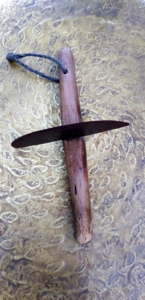The Ifugao finger knife, “gamlang” is a cutting tool used specifically for Ifugao rice varieties, referred to as tinawon. The tool is formed by a wooden handle and an iron blade in the middle of the rod. Gamlang is used, instead of the more ubiquitous sickle, because tinawon are taller than lowland, commercial rice varieties. In addition, the manner of storing harvested rice – bundled, not threshed – is more expedient with gamulang instead of the sickle.
Farming and rice-grain cultivation is an integral part of the societies of Southeast Asia in general, and in the peoples of the Philippine Cordillera in particular. As such, the development of specialized tools and farming equipment was itself a cultural necessity. The gamlang, or the finger knife, represents an apotheosis in this development as a traditionally important harvesting device, even taking precedence over more advanced technology. Although using the finger knife to harvest rice is labor-intensive and time-consuming since only one or two strands of rice are cut per slice, there are several functional benefits and cultural preferences that explain why Ifugao prefer the finger knife rather than the sickle.
Functionally, the gamlang is better adapted to the tall tinawon varieties, as opposed to the commercial rice varieties. Before the shift to commercial rice varieties, lowland rice farmers (such as in Bicol), used the same tool.
The continued use of the finger knife also reflects the importance of cultural values and traditions in Ifugao rice farming, which promotes sustainable agricultural practices and a community-based social system. For example, the gamlang’s slower rice harvesting process allows more villagers of all genders to take part in the harvest, which helps decrease the wealth gap and promotes community sharing values. Furthermore, the Ifugao rice varieties’ slower cycles have instilled cultural traditions like a rest period before harvest to demonstrate respect for the soil and rice plants, which allows the soil time to replenish its nutrients. Additionally, elder women in Ifugao society are highly respected as the “seed selectors” and their knowledge of the Ifugao rice varieties are viewed as invaluable to future generations. Continuing the usage of the traditional farming techniques such as the finger knife encourages cultural values of respecting and learning from elders, as well as a social hierarchy that emphasizes taking care of these elders. In contrast, the introduction of the sickle and commercial rice farming in similar communities has decreased the value of this knowledge, thus changing communities’ social systems and values.


